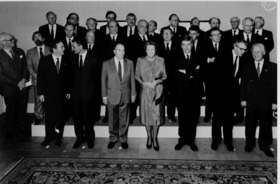

The Treaty of Maastricht, also known as the Treaty on European Union (TEU), paved the way for the further European integration, in particular by introducing the Economic and Monetary Union. It represents the biggest development of the treaties so far. Signed in 1992, it came into force on 1st November 1993.
By modifying the previous treaties - Paris, Rome, and the Single European Act - a political union was proclaimed.
The new policy areas were divided into two new intergovernmental pillars in addition to the first supra-national community pillar. The second pillar is the Common Foreign and Security Policy (CFSP), and the third pillar is Justice and Home Affairs (JHA).
Notes
The Treaty of Maastricht:
Britain and the Treaty of Maastricht
In 1989, Britain alone, of all the 12 member states, opposed the idea of a Social Chapter to accompany the new moves towards European integration, which finally resulted in the Maastricht Treaty of 1992.
The British Prime Minister, John Major, secured British opt-outs from the Maastricht treaty on two major areas - the Social Chapter and moves towards a single currency. The Social Chapter was later ratified by Tony Blair's New Labour government in 1997.
Links
http://europa.eu.int/en/record/mt/top.html